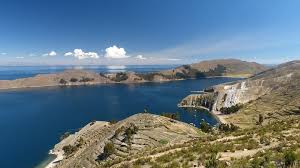WIDER IMAGE-Lake Titicaca, once considered Andean deity, faces pollution threat

- Country:
- Peru
Isaac Callizaya, 39, grew up with the sound of waves lapping on the shores of Lake Titicaca, a giant body of water on the border between Bolivia and Peru that at 3,800 meters (12,500 ft) above sea level is the highest navigable lake in the world. The island fishing community near Titicaca's southern tip that he was born into has seen big changes over the years. Many have moved away from the village on Pariti island, while urban sprawl from nearby cities has created a rising problem of pollution, altering the lake's landscape and forcing those that live around it to adapt.
"When I was a child in the nineties, all families on the island lived off fishing. Today only three families are fishing, catching just some 20 fishes per day," Callizaya says. He himself now has a home in the nearby city of El Alto. "Before the year 2000, there were around 50 students at the primary level (on the island). This year we only have one."
Environmentalists are getting worried about the long-term impact to the lake, a popular destination for visitors to the region, who come to see its icy azure waters with their Andean mountain backdrop and traditional communities, some of whom live on manmade islands constructed entirely from reeds. The lake was once considered a deity by the pre-Columbian people that lived on its shores. As well as native plants and animals, such as the enormous endemic Titicaca water frog, it supports millions of human beings that live nearby – including in the rapidly expanding Bolivian city of El Alto, some 40 kilometers (25 miles) to the east.
The communities around the lake live off fishing, tourism, farming animals and local product "chuño" - potatoes that are laid out overnight to be freeze-dried. Its high-altitude environment is of major interest to climate change researchers, too, because ecosystems of its kind are highly sensitive to global warming, making it an early-warning marker of changes happening more broadly to the planet.
Xavier Lazzaro, an aquatic systems specialist with French research institute IRD, says a shortage of water treatment plants, local industry, tourism, and global warming are all affecting the lake, especially the smaller and shallower "Lago Menor." Lazzaro, who has been closely following pollutants in the lake for many years, is using a solar-powered buoy to do real-time measurements of water quality. He says there is not yet enough data to reliably illustrate the size of the problem.
Over time, a buildup of sediments, toxic blooms, and climate change could cause the Lago Menor to become shallower and eventually dry up, he says. "This catastrophic scenario is not science fiction. Of course, it will take decades, centuries to happen," he says, while driving through the high-altitude mountains overlooking the lake. "It will be faster if no action is taken."
The local governments have taken steps to try and clean up the lake, though it's a hard battle to win outright. Oscar Limachi, 48, a member of the local Qewaya community who works as a tour guide on the lake, says that waste from El Alto and a lack of understanding about pollution risk changing the habitat forever.
"It is also our fault, people throw garbage and plastic everywhere, they don't understand this is polluting," he says, adding that many plant varieties in the lake had already vanished. "Fish used to live, eat and lay their eggs amongst these plants. Now there are no plants, so no fish," he says. "We are afraid that someday the fish will disappear or migrate forever."
Photo essay here https://reut.rs/2lZvEm1 The photographer on this story was part of the 2018 Reuters photojournalism grant program.
(This story has not been edited by Devdiscourse staff and is auto-generated from a syndicated feed.)
ALSO READ
Transgender community in Assam demands improved healthcare, job opportunities, and anti-bullying laws ahead of LS polls
"It's so funny": Alison Brie on 'Community' movie script
AJP chief Lurinjyoti Gogoi criticizes CAA as unacceptable to Assam's indigenous community
US Women's Players Association Stands in Solidarity with LGBTQ Community
JNU Vice-Chancellor praises university's academic community for achieving top spot in 2024 QS rankings










